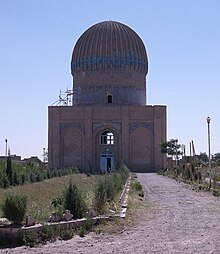Gauhar-Schad
Gauhar-Schad (also Gouhar-Schad , Persian گوهر شاد, DMG Gauhar-i Šād , 'happy / cheerful jewel'; † July 31, 1457 ) with the title Agha was a remarkably influential wife of the Timurid ruler Shah-Ruch (r. 1405–1447), to whom she bore three daughters and three sons, including the versatile Prince Bāisonqur (1397–1433) and the "Sultan of Astronomers" Ulugh-Beg (r. 1447–1449). Together with her brothers and other relatives, she had a decisive political and cultural influence on the history of the Timurid dynasty.
Gauhar-Schad, whose father Giyath ad-Din Tarchan had served as emir under Timur (r. 1370-1405) , was not the main wife of Shah Ruch, but was particularly close to the ruler and influenced him (and Bāisonqur) in his political Decisions. Even when her husband fell ill in 1444/45 and finally died in 1447, she interfered in state affairs and tried together with her relatives, above all the so-called Tarchan emirs, in favor of her grandson Ala ad-Daula and his son Ibrahim in to intervene in the line of succession, but with which she had no lasting success. After Ala ad-Daula had freed her and her followers on April 30, 1447 from captivity with Abd al-Latif ibn Ulugh-Beg (r. 1449-1450), Gauhar-Schad tried to mediate between the rival Timurid princes in 1456/57. But since this threatened the dominance of the emirs of Herat , Shah Mahmud ibn Abi l-Qasim Babur, the latter had the majority of the Tarchan emirs executed by his senior emir Shir Hajji. When Ala ad-Daula then moved against Herat and Shah Mahmud and his followers fled, Gauhar-Schad entrusted the defense of the city to the Kadi Qutb ad-Din Anmad Imami, who handed Herat over to Ibrahim on May 31, 1457 without resistance. On July 19, however, the city fell to Sultan Abu Said (ruled 1451–1469), who had Gauhar-Schad executed in 1457 for her support for Ibrahim. When Abu Said was later captured by the Aq Qoyunlu , Uzun Hasan handed him over to Gauhar-Schad's great-grandson Yadgar Muhammad on February 5, 1469, who beheaded him in revenge.
Gauhar-Schad is known as a great patron of Persian literature , art and architecture . Around 100 Persian poets (of the "Herater School") worked at their court, the most important of which is certainly Jami . In architecture, her name stands out, along with that of her son Bāisonqur and that of the builder Qiwam ad-Din Schirazi. In 1418, for example, she commissioned the construction of the Gauharschad Friday Mosque of Mashhad , which she supported with a pious foundation in 1426, and had a musallā (or mosque) and a madrasa complex built in Herat from 1417 to 1437/38 , which she also built in 1432 completed mausoleum is attached. In addition to the queen herself, seven Timurid princes were buried here, including Bāisonqur.
literature
- Wilhelm Barthold : Four Studies on the History of Central Asia. Volume II: Ulugh Beg. Leiden 1958.
Web links
- Gauhar Schad Mosque in Mashhad
- Gauhar-Schad's Musalla complex in Herat
- Gauhar-Schads Madrasa and Mausoleum in Herat
Remarks
- ↑ The daughters were called Maryam-Sultan, Saadat-Sultan and Qutlugh-Terken Agha, the third son was Muhammad Juki.
- ↑ That was the Genghisidin Malikat Agha.
- ↑ Another reason was the fact that Shir Hajji refused to serve Abu Said while Gauhar-Schad was alive and so he feared their revenge for the murder of the Tarchan emirs.
| personal data | |
|---|---|
| SURNAME | Gauhar-Schad |
| ALTERNATIVE NAMES | Gauharschad, Gouhar-Schad |
| BRIEF DESCRIPTION | Timurid princess |
| DATE OF BIRTH | 14th Century |
| DATE OF DEATH | July 31, 1457 |

